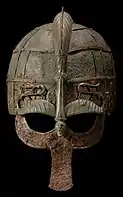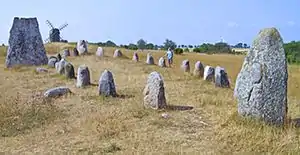Sutton Hoo
Sutton Hoo is the site of two early medieval cemeteries dating from the 6th to 7th centuries near Woodbridge, in Suffolk, England. Archaeologists have been excavating the area since 1938. One cemetery had an undisturbed ship burial with a wealth of Anglo-Saxon artefacts. Most of these objects are now held by the British Museum. Scholars believe Rædwald of East Anglia is the most likely person to have been buried in the ship. The site is important in establishing the history of the Anglo-Saxon kingdom of East Anglia as well as illuminating the early Anglo-Saxon period which lacked historical documentation.
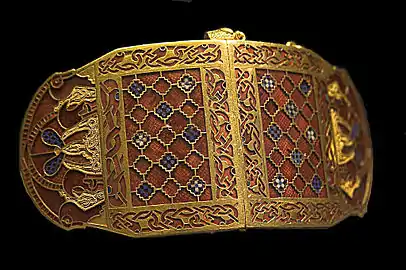 Gold Shoulder Clasp, with inlays of garnets and glass | |
| Location | Woodbridge, Suffolk, England |
|---|---|
| Type | Two early medieval cemeteries, one with ship burial |
| Site notes | |
| Ownership | National Trust |
The site was first excavated by Basil Brown under the auspices of the landowner Edith Pretty, but when its significance became apparent, national experts took over. During the 1960s and 1980s, the wider area was explored by archaeologists and many other individual burials were revealed. The artefacts comprise what is considered the greatest treasure ever discovered in the UK.[1] Those found in the burial chamber include a suite of metalwork dress fittings in gold and gems, a ceremonial helmet, a shield and sword, a lyre, and silver plate from the Byzantine Empire.
The ship burial has prompted comparisons with the world of the Old English poem Beowulf. The poem is partly set in Götaland in southern Sweden, which has archaeological parallels to some of the finds from Sutton Hoo.

The cemeteries are located close to the River Deben estuary and other archaeological sites. They appear as a group of approximately 20 earthen mounds that rise slightly above the horizon of the hill-spur when viewed from the opposite bank. The newer burial ground is situated on a second hill-spur about 500 metres (1,600 ft) upstream of the first. It was discovered and partially explored in 2000 during preliminary work for the construction of an Exhibition Hall for tourists. This site also has burials, but the tops of their mounds had been obliterated by later agricultural activity.
The nearby visitor centre contains original artefacts, replicas of finds and a reconstruction of the ship burial chamber. The site is in the care of the National Trust.
Toponym
Sutton Hoo derives its name from Old English. Sut combined with tun means the "southern farmstead" or "settlement" and hoh refers to a hill "shaped like a heel spur".[2][3] The same ending survives in a few other placenames, notably Plymouth Hoe and Fingringhoe.[4]
Location
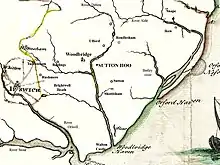
Sutton Hoo, which lies along the banks of the tidal estuary of the River Deben, lends its name to the small Suffolk village of Sutton and its parish. On the opposite bank, is the small harbour town of Woodbridge, which stands about 7 mi (11 km) from the North Sea and just a little below the lowest convenient fording place.[lower-alpha 1] It formed a path of entry into East Anglia during the period that followed the end of Roman imperial rule in the 5th century.[6]
South of Woodbridge, there are 6th-century burial grounds at Rushmere, Little Bealings, and Tuddenham St Martin[7] and circling Brightwell Heath, the site of mounds that date from the Bronze Age.[8] There are cemeteries of a similar date at Rendlesham and Ufford.[9] A ship-burial at Snape is the only one in England that can be compared to the example at Sutton Hoo.[10]
The territory between the Orwell and the watersheds of the Alde and Deben rivers may have been an early centre of royal power, originally centred upon Rendlesham or Sutton Hoo, and a primary component in the formation of the East Anglian kingdom.[lower-alpha 2] In the early 7th century, Gipeswic (modern Ipswich) began its growth as a centre for foreign trade,[11] Botolph's monastery at Iken was founded by royal grant in 654,[12] and Bede identified Rendlesham as the site of Æthelwold's royal dwelling.[13]
Early settlement
Neolithic and Bronze Age
There is evidence that Sutton Hoo was occupied during the Neolithic period, c. 3000 BCE, when woodland in the area was cleared by agriculturalists. They dug small pits that contained flint-tempered earthenware pots. Several pits were near to hollows where large trees had been uprooted: the Neolithic farmers may have associated the hollows with the pots.[14]
During the Bronze Age, when agricultural communities living in Britain were adopting the newly introduced technology of metalworking, timber-framed roundhouses were built at Sutton Hoo, with wattle and daub walling and thatched roofs. The best surviving example contained a ring of upright posts, up to 30 centimetres (12 in) in diameter, with one pair suggesting an entrance to the south-east. In the central hearth, a faience bead had been dropped. The farmers who dwelt in this house used decorated Beaker-style pottery, cultivated barley, oats, and wheat, and collected hazelnuts. They dug ditches that marked the surrounding grassland into sections, indicating land ownership. The acidic sandy soil eventually became leached and infertile, and it was likely that for this reason, the settlement was eventually abandoned, to be replaced in the Middle Bronze Age (1500-1000 BCE) by sheep or cattle, which were enclosed by wooden stakes.[15]
Iron Age and Romano-British period
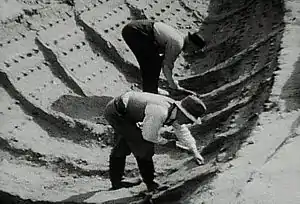
During the Iron Age, iron replaced copper and bronze as the dominant form of metal used in the British Isles. In the Middle Iron Age (around 500 BCE), people living in the Sutton Hoo area began to grow crops again, dividing the land into small enclosures now known as Celtic fields.[17] The use of narrow trenches implies grape cultivation, whilst in other places, small pockets of dark soil indicate that big cabbages may have been grown.[18] This cultivation continued into the Romano-British period, from 43 to around 410. Life for the Britons remained unaffected by the arrival of the Romans. Several artefacts from the period, including a few fragments of pottery and a discarded fibula, have been found. As the peoples of Western Europe were encouraged by the Empire to maximise the use of land for growing crops, the area around Sutton Hoo suffered degradation and soil loss. It was eventually abandoned and became overgrown.[18]
Anglo-Saxon cemetery
Background
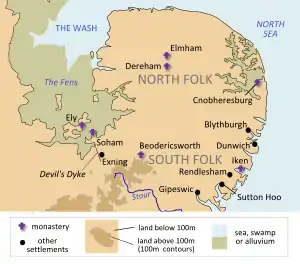
Following the withdrawal of the Romans from southern Britain after 410, Germanic tribes such as the Angles and Saxons began to settle in the southeastern part of the island. East Anglia is regarded by many scholars as a region in which this settlement was particularly early and dense; the area's name derives from that of the Angles. Over time, the remnants of the pre-existing Brittonic population adopted the culture of the newcomers.[19][20][21]
During this period, southern Britain became divided up into a number of small independent kingdoms. Several pagan cemeteries from the kingdom of the East Angles have been found, most notably at Spong Hill and Snape, where a large number of cremations and inhumations were found. Many of the graves were accompanied by grave goods, which included combs, tweezers and brooches, as well as weapons. Sacrificed animals had been placed in the graves.[22]
At the time when the Sutton Hoo cemetery was in use, the River Deben would have formed part of a busy trading and transportation network. A number of settlements grew up along the river, most of which would have been small farmsteads, although it seems likely that there was a larger administrative centre as well, where the local aristocracy held court. Archaeologists have speculated that such a centre may have existed at Rendlesham, Melton, Bromeswell or at Sutton Hoo. It has been suggested that the burial mounds used by wealthier families were later appropriated as sites for early churches. In such cases, the mounds would have been destroyed before the churches were constructed.[23]
The Sutton Hoo grave field contained about twenty barrows; it was reserved for people who were buried individually with objects that indicated that they had exceptional wealth or prestige. It was used in this way from around 575 to 625 and contrasts with the Snape cemetery, where the ship-burial and furnished graves were added to a graveyard of buried pots containing cremated ashes.[24]
The cremations and inhumations, Mounds 17 and 14
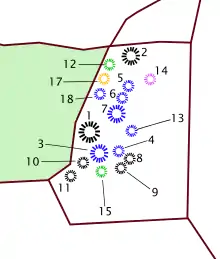
Martin Carver believes that the cremation burials at Sutton Hoo were "among the earliest" in the cemetery.[23] Two were excavated in 1938. Under Mound 3 were the ashes of a man and a horse placed on a wooden trough or dugout bier, a Frankish iron-headed throwing-axe, and imported objects from the eastern Mediterranean, including the lid of a bronze ewer, part of a miniature carved plaque depicting a winged Victory, and fragments of decorated bone from a casket.[25] Under Mound 4 was the cremated remains of a man and a woman, with a horse and perhaps also a dog, as well as fragments of bone gaming-pieces.[26]
In Mounds 5, 6, and 7, Carver found cremations deposited in bronze bowls. In Mound 5 were found gaming-pieces, small iron shears, a cup, and an ivory box. Mound 7 also contained gaming-pieces, as well as an iron-bound bucket, a sword-belt fitting and a drinking vessel, together with the remains of horse, cattle, red deer, sheep, and pig that had been burnt with the deceased on a pyre. Mound 6 contained cremated animals, gaming-pieces, a sword-belt fitting, and a comb. The Mound 18 grave was very damaged, but of similar kind.[27] Two cremations were found during the 1960s exploration to define the extent of Mound 5, together with two inhumations and a pit with a skull and fragments of decorative foil.[28] In level areas between the mounds, Carver found three furnished inhumations. One small mound held a child's remains, along with his buckle and miniature spear. A man's grave included two belt buckles and a knife, and that of a woman contained a leather bag, a pin and a chatelaine.[29]
The most impressive of the burials without a chamber is that of a young man who was buried with his horse,[30] in Mound 17.[31] The horse would have been sacrificed for the funeral, in a ritual sufficiently standardised to indicate a lack of sentimental attachment to it. Two undisturbed grave-hollows existed side by side under the mound. The man's oak coffin contained his pattern welded sword on his right and his sword-belt, wrapped around the blade, which had a bronze buckle with garnet cloisonné cellwork, two pyramidal strapmounts and a scabbard-buckle. By the man's head were a firesteel and a leather pouch, containing rough garnets and a piece of millefiori glass. Around the coffin were two spears, a shield, a small cauldron and a bronze bowl, a pot, an iron-bound bucket and some animal ribs. In the north-west corner of his grave was a bridle, mounted with circular gilt bronze plaques with interlace ornamentation.[32] These items are on display at Sutton Hoo.

Inhumation graves of this kind are known from both England and Germanic continental Europe,[lower-alpha 3] with most dating from the 6th or early 7th century. In about 1820, an example was excavated at Witnesham.[33] There are other examples at Lakenheath in western Suffolk and in the Snape cemetery:[34] Other examples have been inferred from records of the discovery of horse furniture at Eye and Mildenhall.[35]
Although the grave under Mound 14 had been destroyed almost completely by robbing, apparently during a heavy rainstorm, it had contained exceptionally high-quality goods belonging to a woman. These included a chatelaine, a kidney-shaped purse-lid, a bowl, several buckles, a dress-fastener, and the hinges of a casket, all made of silver, and also a fragment of embroidered cloth.[36]
Mound 2
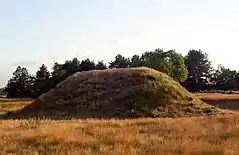
This important grave, damaged by looters, was probably the source of the many iron ship-rivets found at Sutton Hoo in 1860. In 1938, when the mound was excavated, iron rivets were found, which enabled the Mound 2 grave to be interpreted as a small boat.[37] Carver's re-investigation revealed that there was a rectangular plank-lined chamber, 5 metres (16 ft) long by 2 metres (6 ft 7 in) wide, sunk below the land surface, with the body and grave-goods laid out in it. A small ship had been placed over this in an east-west alignment before a large earth mound was raised.[38]
Chemical analysis of the chamber floor has suggested the presence of a body in the south-western corner. The goods found included fragments of a blue glass cup with a trailed decoration, similar to the recent find from the Prittlewell tomb in Essex. There were two gilt-bronze discs with animal interlace ornament, a bronze brooch, a silver buckle, and a gold-coated stud from a buckle. Four objects had a special kinship with the Mound 1 finds: the tip of a sword blade showed elaborate pattern welding; silver-gilt drinking horn-mounts (struck from the same dies as those in Mound 1); and the similarity of two fragments of dragon-like mounts or plaques.[39] Although the rituals were not identical, the association of the contents of the grave shows a connection between the two burials.[40]
The execution burials
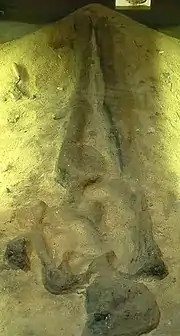
The cemetery contained remains of people who died violently, in some cases by hanging and decapitation. Often the bones have not survived, but the flesh had stained the sandy soil: the soil was laminated as digging progressed, so that the emaciated figures of the dead were revealed. Casts were taken of several of these.
The identification and discussion of these burials was led by Carver.[41] Two main groups were excavated, with one arranged around Mound 5 and the other situated beyond the barrow cemetery limits in the field to the east. It is thought that a gallows once stood on Mound 5, in a prominent position near to a significant river-crossing point, and that the graves contained the bodies of criminals, possibly executed from the 8th and 9th centuries onwards.
The new grave field
In 2000, a Suffolk County Council team excavated the site intended for the National Trust's new visitor centre, north of Tranmer House, at a point where the ridge of the Deben valley veers westwards to form a promontory. When the topsoil was removed, early Anglo-Saxon burials were discovered in one corner, with some possessing high-status objects.[42] The area had first attracted attention with the discovery of part of a 6th-century bronze vessel, of eastern Mediterranean origin, that had probably formed part of a furnished burial. The outer surface of the so-called "Bromewell bucket" was decorated with a Syrian- or Nubian-style frieze, depicting naked warriors in combat with leaping lions, and had an inscription in Greek that translated as "Use this in good health, Master Count, for many happy years."[43]
In an area near to a former rose garden, a group of moderate-sized burial mounds was identified. They had long since been levelled, but their position was shown by circular ditches that each enclosed a small deposit indicating the presence of a single burial, probably of unurned human ashes. One burial lay in an irregular oval pit that contained two vessels, a stamped black earthenware urn of late 6th-century type, and a well-preserved large bronze hanging bowl, with openwork hook escutcheons and a related circular mount at the centre.[44] In another burial, a man had been laid next to his spear and covered with a shield of normal size. The shield bore an ornamented boss-stud and two fine metal mounts, ornamented with a predatory bird and a dragon-like creature.[45]
Mound 1

The ship-burial discovered under Mound 1 in 1939 contained one of the most magnificent archaeological finds in England for its size and completeness, far-reaching connections, the quality and beauty of its contents, and for the profound interest it generated.[46][47]
The burial
Although practically none of the original timber survived, the form of the ship was perfectly preserved.[48] Stains in the sand had replaced the wood but had preserved many construction details. Nearly all of the iron planking rivets were in their original places. It was possible to survey the original ship, which was found to be 27 metres (89 ft) long, pointed at either end with tall rising stem and stern posts and widening to 4.4 metres (14 ft) in the beam amidships with an inboard depth of 1.5 metres (4 ft 11 in) over the keel line. From the keel board, the hull was constructed clinker-fashion with nine planks on either side, fastened with rivets. Twenty-six wooden frames strengthened the form. Repairs were visible: this had been a seagoing vessel of excellent craftsmanship, but there was no descending keel. The decking, benches and mast were removed. In the fore and aft sections along the gunwales, there were oar-rests shaped like the Anglo-Saxon letter "thorn", indicating that there may have been positions for forty oarsmen. The central chamber had timber walls at either end and a roof, which was probably pitched.
The heavy oak vessel had been hauled from the river up the hill and lowered into a prepared trench, so only the tops of the stem and stern posts rose above the land surface.[49] After the addition of the body and the artefacts, an oval mound was constructed, which covered the ship and rose above the horizon at the riverward side of the cemetery.[50] The view to the river is now obscured by Top Hat Wood, but the mound would have been a visible symbol of power to those using the waterway. This appears to have been the final occasion upon which the Sutton Hoo cemetery was used for its original purpose.[51]
Long afterwards, the roof collapsed violently under the weight of the mound, compressing the ship's contents into a seam of earth.[52]
The body in the ship-burial
As a body was not found, there was early speculation that the ship-burial was a cenotaph, but soil analyses conducted in 1967 found phosphate traces, supporting the view that a body had disappeared in the acidic soil.[53] The presence of a platform (or a large coffin) that was about 9 feet (2.7 m) long was indicated.[54] An iron-bound wooden bucket, an iron lamp containing beeswax, and a bottle of north continental manufacture were close by. The objects around the body indicate that it lay with the head at the west end of the wooden structure.
Artefacts near the body have been identified as regalia, pointing to its being that of a king. Most of the suggestions for the occupant are East Anglian kings because of the proximity of the royal vill of Rendlesham. Since 1940, when H.M. Chadwick first ventured that the ship-burial was probably the grave of Rædwald,[55] scholarly opinion divided between Raedwald and his son (or step-son) Sigeberht.[53] The man who was buried under Mound 1 cannot be identified,[56] but the identification with Rædwald still has widespread scholarly acceptance. But from time to time, other identifications are suggested, including his son Eorpwald of East Anglia, who succeeded his father in about 624. Rædwald is the most likely of the candidates because of the high quality of the imported and commissioned materials and the resources needed to assemble them, the authority that the gold was intended to convey, the community involvement required to conduct the ritual at a cemetery reserved for an elite, the close proximity of Sutton Hoo to Rendlesham and the probable date horizons.[lower-alpha 4] As of 2019, the refurbished museum on the site states that the body is Rædwald while the British Museum just says a "King of East Anglia". Analysis of the Merovingian coins by Gareth Williams, Curator of Early Medieval Coinage at the British Museum, has narrowed the date of the burial to 610 to 635. This makes Sigeberht, who died in 637, less likely. Rædwald is still the favourite, although Eorpwald also fits the timescale as he died 627–28.[57]
Closer inspection of the sword hilt suggests that the occupant was left-handed, as the hilt's malleable gold pieces are worn down on the opposite side than would be expected with a right-handed owner.[58] The unorthodox sword placement on the right side of the body supports this theory, as other Anglo Saxon burials placed the sword on the left side of the body.[59]
The objects in the burial chamber
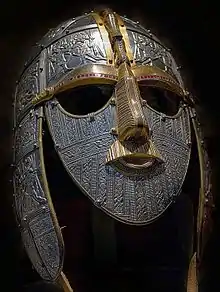
David M. Wilson has remarked that the metal artworks found in the Sutton Hoo graves were "work of the highest quality, not only in English but in European terms".[60]
Sutton Hoo is a cornerstone of the study of art in Britain in the 6th–9th centuries. George Henderson has described the ship treasures as "the first proven hothouse for the incubation of the Insular style".[61] The gold and garnet fittings show the creative fusion of earlier techniques and motifs by a master goldsmith. Insular art drew upon Irish, Pictish, Anglo-Saxon, native British and Mediterranean artistic sources: the 7th-century Book of Durrow owes as much to Pictish sculpture, British millefiori and enamelwork and Anglo-Saxon cloisonné metalwork as it does to Irish art.[lower-alpha 5] The Sutton Hoo treasures represent a continuum from pre-Christian royal accumulation of precious objects from diverse cultural sources, through to the art of gospel books, shrines and liturgical or dynastic objects.
The head area: the helmet, bowls and spoons
On the head's left side was placed a "crested" and masked helmet wrapped in cloths.[62] With its panels of tinned bronze and assembled mounts, the decoration is directly comparable to that found on helmets from the Vendel and Valsgärde burial sites in eastern Sweden.[63] The Sutton Hoo helmet differs from the Swedish examples in having an iron skull of a single vaulted shell and has a full face mask, a solid neck guard and deep cheekpieces. These features have been used to suggest an English origin for the helmet's basic structure; the deep cheekpieces have parallels in the Coppergate helmet, found in York.[64] Although outwardly very like the Swedish examples, the Sutton Hoo helmet is a product of better craftsmanship. Helmets are extremely rare finds. No other such figural plaques were known in England, apart from a fragment from a burial at Caenby, Lincolnshire,[65] until the 2009 discovery of the Staffordshire hoard, which contained many.[66] The helmet rusted in the grave and was shattered into hundreds of tiny fragments when the chamber roof collapsed. Restoration of the helmet thus involved the meticulous identification, grouping and orientation of the surviving fragments before it could be reconstructed.[lower-alpha 6]
To the head's right was placed inverted a nested set of ten silver bowls, probably made in the Eastern Empire during the sixth century. Beneath them were two silver spoons, possibly from Byzantium, of a type bearing names of the Apostles.[72] One spoon is marked in original nielloed Greek lettering with the name of PAULOS, "Paul". The other, matching spoon had been modified using lettering conventions of a Frankish coin-die cutter, to read SAULOS, "Saul". One theory suggests that the spoons (and possibly also the bowls) were a baptismal gift for the buried person.[73]
The weapons on the right side of the body
On the right of the "body" lay a set of spears, tips uppermost, including three barbed angons, with their heads thrust through a handle of the bronze bowl.[74] Nearby was a wand with a small mount depicting a wolf.[75] Closer to the body lay the sword with a gold and garnet cloisonné pommel 85 centimetres (33 in) long, its pattern welded blade still within its scabbard, with superlative scabbard-bosses of domed cellwork and pyramidal mounts.[76] Attached to this and lying toward the body was the sword harness and belt, fitted with a suite of gold mounts and strap-distributors of extremely intricate garnet cellwork ornament.[77]
Upper body area: purse, shoulder-clasps and great buckle
Together with the sword harness and scabbard mounts, the gold and garnet objects found in the upper body space, which form a co-ordinated ensemble, are among the true wonders of Sutton Hoo. Their artistic and technical quality is exceptional.[78]
The "great" gold buckle is made in three parts.[79] The plate is a long ovoid of a meandering but symmetrical outline with densely interwoven and interpenetrating ribbon animals rendered in chip-carving on the front. The gold surfaces are punched to receive niello detail. The plate is hollow and has a hinged back, forming a secret chamber, possibly for a relic. Both the tongue-plate and hoop are solid, ornamented, and expertly engineered.
Each shoulder-clasp consists of two matching curved halves, hinged upon a long removable chained pin.[80] The surfaces display panels of interlocking stepped garnets and chequer millefiori insets, surrounded by interlaced ornament of Germanic Style II ribbon animals. The half-round clasp ends contain garnet-work of interlocking wild boars with filigree surrounds. On the underside of the mounts are lugs for attachment to a stiff leather cuirass. The function of the clasps is to hold together the two halves of such armour so that it can fit the torso closely in the Roman manner.[81] The cuirass itself, possibly worn in the grave, did not survive. No other Anglo-Saxon cuirass clasps are known.
The ornamental purse-lid, covering a lost leather pouch, hung from the waist-belt.[82] The lid consists of a kidney-shaped cell work-frame enclosing a sheet of the horn, on which were mounted pairs of exquisite garnet cell work plaques depicting birds, wolves devouring men (or the ancient motif of the Master of Animals), geometric motifs and a double panel showing animals with interlaced extremities. The maker derived these images from the ornament of the Swedish-style helmets and shield-mounts. In his work, they are transferred into the cell work medium with dazzling technical and artistic virtuosity.
These are the work of a master-goldsmith who had access to an East Anglian armoury containing the objects used as pattern sources. As an ensemble they enabled the patron to appear imperial.[lower-alpha 7][83][84] The purse contained thirty-seven gold shillings or tremisses, each originating from a different Frankish mint. They were deliberately collected. There were also three blank coins and two small ingots.[85] This has prompted various explanations: possibly like the Roman obolus they may have been left to pay the forty ghostly oarsmen in the afterworld or were a funeral tribute, or an expression of allegiance.[86] They provide the primary evidence for the date of the burial, which was debatably in the third decade of the 7th century.[87]
The lower body and 'heaps' areas
In the area corresponding to the lower legs of the body were laid out various drinking vessels, including a pair of drinking horns made from the horns of an aurochs, extinct since early medieval times.[88] These have matching die-stamped gilt rim mounts and vandykes, of similar workmanship and design to the shield mounts, and exactly similar to the surviving horn vandykes from Mound 2.[89] In the same area stood a set of maplewood cups with similar rim-mounts and vandykes,[90] and a heap of folded textiles lay on the left side.
A large quantity of material including metal objects and textiles was formed into two folded or packed heaps on the east end of the central wooden structure. This included the extremely rare survival of a long coat of ring-mail, made of alternate rows of welded and riveted iron links,[91] two hanging bowls,[92] leather shoes,[93] a cushion stuffed with feathers, folded objects of leather and a wooden platter. At one side of the heaps lay an iron hammer-axe with a long iron handle, possibly a weapon.[94]
On top of the folded heaps was set a fluted silver dish with drop handles, probably made in Italy, with the relief image of a female head in late Roman style worked into the bowl.[95] This contained a series of small burr-wood cups with rim-mounts, combs of antler, small metal knives, a small silver bowl, and various other small effects (possibly toilet equipment), and including a bone gaming-piece, thought to be the 'king piece' from a set.[96] (Traces of bone above the head position have suggested that a gaming-board was possibly set out, as at Taplow.) Above these was a silver ladle with gilt chevron ornament, also of Mediterranean origin.[97]
Over the whole of this, perched on top of the heaps, or their container, if there was one, lay a very large round silver platter with chased ornament, made in the Eastern Empire circa 500 and bearing the control stamps of Emperor Anastasius I (491–518).[98] On this plate was deposited a piece of unburnt bone of uncertain derivation.[99] The assemblage of Mediterranean silverware in the Sutton Hoo grave is unique for this period in Britain and Europe.[100]
The west and east walls
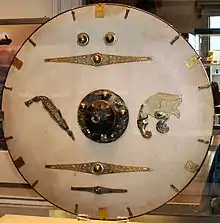
Along the inner west wall (i.e. the head end) at the north-west corner stood a tall iron stand with a grid near the top.[101] Beside this rested a very large circular shield,[102] with a central boss, mounted with garnets and with die-pressed plaques of interlaced animal ornament.[lower-alpha 8] The shield front displayed two large emblems with garnet settings, one a composite metal predatory bird and the other a flying dragon. It also bore animal-ornamented sheet strips directly die-linked to examples from the early cemetery at Vendel[104] near Old Uppsala in Sweden.[105] A small bell, possibly for an animal, lay nearby.
Along the wall was a long square-sectioned whetstone, tapered at either end and carved with human faces on each side. A ring mount, topped by a bronze antlered stag figurine, was fixed to the upper end, possibly made to resemble a late Roman consular sceptre.[106] The purpose of the sceptre has generated considerable debate and a number of theories, some of which point to the potential religious significance of the stag.[107] South of the sceptre was an iron-bound wooden bucket, one of several in the grave.[108]
In the south-west corner was a group of objects which may have been hung up, but when discovered, were compressed together. They included a Coptic or eastern Mediterranean bronze bowl with drop handles and figures of animals,[109] found below a badly deformed six-stringed Anglo-Saxon lyre in a beaver-skin bag, of a Germanic type found in wealthy Anglo-Saxon and north European graves of this date.[110] Uppermost was a large and exceptionally elaborate three-hooked hanging bowl of Insular production, with champleve enamel and millefiori mounts showing fine-line spiral ornament and red cross motifs and with an enamelled metal fish mounted to swivel on a pin within the bowl.[111]
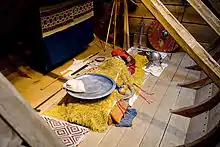
At the east end of the chamber, near the north corner, stood an iron-bound tub of yew containing a smaller bucket. To the south were two small bronze cauldrons, which were probably hung against the wall. A large carinated bronze cauldron, similar to the example from a chamber-grave at Taplow, with iron mounts and two ring-handles was hung by one handle.[112] Nearby lay an iron chain almost 3.5 metres (11 ft) long, of complex ornamental sections and wrought links, for suspending a cauldron from the beams of a large hall. The chain was the product of a British tradition dating back to pre-Roman times.[113] All these items were of a domestic character.
Textiles
The burial chamber was evidently rich in textiles, represented by many fragments preserved, or by chemicals formed by corrosion.[114] They included quantities of twill, possibly from cloaks, blankets or hangings, and the remains of cloaks with characteristic long-pile weaving. There appear to have been more exotic coloured hangings or spreads, including some (possibly imported) woven in stepped lozenge patterns using a Syrian technique in which the weft is looped around the warp to create a textured surface. Two other colour-patterned textiles, near the head and foot of the body area, resemble Scandinavian work of the same period.
Comparisons
Similarities with Swedish burials
A series of excavations in 1881–83 by Hjalmar Stolpe revealed 14 graves in the village of Vendel in eastern Sweden.[115] Several of the burials were contained in boats up to 9 metres (30 ft) long and were furnished with swords, shields, helmets and other items.[116] Beginning in 1928, another gravefield containing princely burials was excavated at Valsgärde.[117] The pagan custom of furnished burial may have reached a natural culmination as Christianity began to make its mark.[118] The Vendel and Valsgärde graves also included ships, similar artefact groups, and many sacrificed animals.[119] Ship-burials for this period are largely confined to eastern Sweden and East Anglia. The earlier mound-burials at Old Uppsala, in the same region, have a more direct bearing on the Beowulf story, but do not contain ship-burials. The famous Gokstad and Oseberg ship-burials of Norway are of a later date.
The inclusion of drinking-horns, lyre, sword and shield, bronze and glass vessels is typical of high-status chamber-graves in England.[120] The similar selection and arrangement of the goods in these graves indicates a conformity of household possessions and funeral customs between people of this status, with the Sutton Hoo ship-burial being a uniquely elaborated version, of exceptional quality. Unusually, Sutton Hoo included regalia and instruments of power and had direct Scandinavian connections. A possible explanation for such connections lies in the well-attested northern custom by which the children of leading men were often raised away from home by a distinguished friend or relative.[121] A future East Anglian king, whilst being fostered in Sweden, could have acquired high-quality objects and made contact with armourers, before returning to East Anglia to rule.
Carver argues that pagan East Anglian rulers would have responded to the growing encroachment of Roman Christendom by employing ever more elaborate cremation rituals, so expressing defiance and independence. The execution victims, if not sacrificed for the ship-burial, perhaps suffered for their dissent from the cult of Christian royalty:[122] their executions may coincide in date with the period of Mercian hegemony over East Anglia in about 760–825.[123]
Connections with Beowulf
Beowulf, the Old English epic poem set in Denmark and Sweden (mostly Götaland) during the first half of the 6th century, opens with the funeral of the great Danish king, Skjöldr (a.k.a. Scyld Scefing or Shield Sheafson), in a ship laden with treasure and has other descriptions of hoards, including Beowulf's own mound-burial. Its picture of warrior life in the hall of the Danish Scylding clan, with formal mead-drinking, minstrel recitation to the lyre and the rewarding of valour with gifts, and the description of a helmet, could all be illustrated from the Sutton Hoo finds. The east Sweden connections seen in several of the Sutton Hoo artefacts reinforce the link to the world of Beowulf.[124]
Several scholars have explained how interpretations of Sutton Hoo and Beowulf have had a bearing on the other.[125][126] Roberta Frank has demonstrated that the Sutton Hoo discovery initiated an increase in appearances of ‘silver’ in Beowulf translations despite the absence of Old English words connoting silver in the poem.[126]
Sam Newton draws together the Sutton Hoo and Beowulf links with the Raedwald identification. Using genealogical data, he argues that the Wuffing dynasty derived from the Geatish house of Wulfing, mentioned in both Beowulf and the poem Widsith. Possibly the oral materials from which Beowulf was assembled belonged to East Anglian royal tradition, and they and the ship-burial took shape together as heroic restatements of migration-age origins.[127]
Christopher Brooke in The Saxon & Norman Kings (1963) gives copious notes regarding Beowulf and the Sutton Hoo treasure and relates the life of the chiefs in the literary work with the 1939 discovery of the ship-burial.
Excavations
Prior to 1938
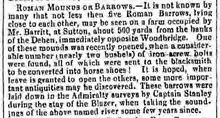
In medieval times the westerly end of the mound was dug away and a boundary ditch was laid out. Therefore, when looters dug into the apparent centre during the sixteenth century, they missed the real centre: nor could they have foreseen that the deposit lay very deep in the belly of a buried ship, well below the level of the land surface.[128]
In the 16th century, a pit, dated by bottle shards left at the bottom, was dug into Mound 1, narrowly missing the burial.[128] The area was explored extensively during the 19th century, when a small viewing platform was constructed,[129] but no useful records were made. In 1860 it was reported that nearly two bushels of iron screw bolts, presumably ship rivets, had been found at the recent opening of a mound and that it was hoped to open others.[130][131]
Basil Brown and Charles Phillips: 1938–1939
In 1910, a mansion with fifteen bedrooms was built a short distance from the mounds and in 1926 the mansion and its arable land was purchased by Colonel Frank Pretty, a retired military officer who had recently married. In 1934, Pretty died, leaving a widow, Edith Pretty, and young son, Robert Dempster Pretty.[132] Following her bereavement, Mrs Pretty became interested in Spiritualism, a popular religious movement that purported to enable the living to communicate with the dead.
Mrs. Pretty in 1937 decided to organize an excavation of the mounds.[133] Through the Ipswich Museum, she obtained the services of Basil Brown, a self-taught Suffolk archaeologist who had taken up full-time investigations of Roman sites for the museum.[134] In June 1938, Pretty took him to the site, offered him accommodation and a wage of 30 shillings a week, and suggested that he start digging at Mound 1.[135] Because it had been disturbed by earlier grave diggers, Brown, in consultation with the Ipswich Museum, decided instead to open three smaller mounds (2, 3 and 4). These only revealed fragmented artefacts, as the mounds had been robbed of valuable items.[136] In Mound 2 he found iron ship-rivets and a disturbed chamber burial that contained unusual fragments of metal and glass artefacts. At first, it was undecided as to whether they were Early Anglo-Saxon or Viking objects.[137] The Ipswich Museum then became involved with the excavations;[138] the finds became part of the museum's collection.
In May 1939, Brown began work on Mound 1, helped by Pretty's gardener John (Jack) Jacobs, her gamekeeper William Spooner, and another estate worker Bert Fuller.[139] (Jacobs lived with his wife and their three children at Sutton Hoo House.) They drove a trench from the east end and on the third day discovered an iron rivet which Brown identified as a ship's rivet.[lower-alpha 9] Within hours others were found still in position. The colossal size of the find became apparent. After several weeks of patiently removing earth from the ship's hull, they reached the burial chamber.[140]

The following month, Charles Phillips of Cambridge University heard rumours of a ship discovery. He was taken to Sutton Hoo by Mr Maynard, the Ipswich Museum curator, and was staggered by what he saw. Within a short time, following discussions with the Ipswich Museum, the British Museum, the Science Museum, and Office of Works, Phillips had taken over responsibility for the excavation of the burial chamber. Initially, Phillips and the British Museum instructed Brown to cease excavating until they could get their team assembled, but he continued working, something which may have saved the site from being looted by treasure hunters.[141] Phillips' team included W.F. Grimes and O.G.S. Crawford of the Ordnance Survey, Peggy Piggott (later known as Margaret Guido) and Stuart Piggott, and other friends and colleagues.[142] Extensive photography of the ship excavation was made by Mercie Lack and Barbara Wagstaff.
The need for secrecy and various vested interests led to a confrontation between Phillips and the Ipswich Museum. In 1935–1936 Phillips and his friend Grahame Clark had taken control of The Prehistoric Society. The curator, Mr. Maynard, then turned his attention to developing Brown's work for the museum. Phillips, who was hostile toward the museum's honorary president, Reid Moir, F.R.S., had now reappeared, and he deliberately excluded Moir and Maynard from the new discovery at Sutton Hoo.[143] After Ipswich Museum prematurely announced the discovery, reporters attempted to access the site, so Mrs. Pretty paid for two policemen to guard the site 24 hours a day.[144]
The finds, having been packed and removed to London, were brought back for a treasure trove inquest held that autumn at Sutton village hall, where it was decided that since the treasure was buried without the intention to recover it, it was the property of Mrs. Pretty as the landowner.[145] Pretty decided to bequeath the treasure as a gift to the nation, so that the meaning and excitement of her discovery could be shared by everyone.[146]
When World War II broke out in September 1939, the grave-goods were put in storage. Sutton Hoo was used as a training ground for military vehicles.[147] Phillips and colleagues produced important publications in 1940 including a dedicated issue of Antiquity.[148]
Rupert Bruce-Mitford: 1965–1971
After Britain's victory in 1945, the Sutton Hoo artefacts were removed from storage. A team, led by Rupert Bruce-Mitford, from the British Museum's Department of British and Medieval Antiquities, determined their nature and helped to reconstruct and replicate the sceptre and helmet.[149] They also oversaw the conservation of the artefacts, to protect them and enable them to be viewed by the public.[150]
From analysing the data collected in 1938–39, Bruce-Mitford concluded that there were still unanswered questions. As a result of his interest in excavating previously unexplored areas of the Sutton Hoo site, a second archaeological investigation was organised. In 1965, a British Museum team began work, continuing until 1971. The ship impression was re-exposed and found to have suffered some damage, not having been back-filled after excavation in 1939. Nevertheless, it remained sufficiently intact for a plaster cast to be taken and a fiberglass shape produced. The decision was then made to destroy the impression in order to excavate underneath. The mound was later restored to its pre-1939 appearance. The team also determined the limits of Mound 5 and investigated evidence of prehistoric activity on the original land-surface.[151] They scientifically analysed and reconstructed some of the finds.
The three volumes of Bruce-Mitford's definitive text, The Sutton Hoo Ship-Burial, were published in 1975, 1978 and 1983.[152]
Martin Carver: 1983–1992
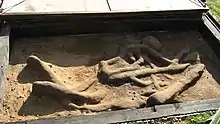
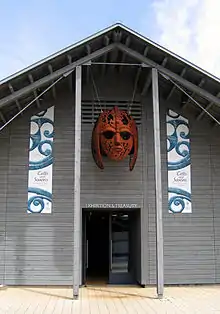
In 1978 a committee was formed in order to mount a third, and even larger excavation at Sutton Hoo. Backed by the Society of Antiquaries of London, the committee proposed an investigation to be led by Philip Rahtz from the University of York and Rupert Bruce-Mitford,[153] but the British Museum's reservations led to the committee deciding to collaborate with the Ashmolean Museum. The committee recognised that much had changed in archaeology since the early 1970s. The Conservatives' privatisation policies signalled a decrease in state support for such projects, whilst the emergence of post-processualism in archaeological theory moved many archaeologists toward focussing on concepts such as social change. The Ashmolean's involvement convinced the British Museum and the Society of Antiquaries to help fund the project. In 1982, Martin Carver from the University of York was appointed to run the excavation, with a research design aimed at exploring "the politics, social organisation and ideology" of Sutton Hoo.[154] Despite opposition by those who considered that funds available could be better used for rescue archaeology, in 1983 the project went ahead.
Carver believed in restoring the overgrown site, much of which was riddled with rabbit warrens.[155] After the site was surveyed using new techniques, the topsoil was stripped across an area that included Mounds 2, 5, 6, 7, 17 and 18. A new map of soil patterns and intrusions was produced that showed that the mounds had been sited in relation to prehistoric and Roman enclosure patterns. Anglo-Saxon graves of execution victims were found which were determined to be younger than the primary mounds. Mound 2 was re-explored and afterwards rebuilt. Mound 17, a previously undisturbed burial, was found to contain a young man, his weapons and goods, and a separate grave for a horse. A substantial part of the gravefield was left unexcavated for the benefit of future investigators and as yet unknown scientific methods.[156]
Exhibition
| External video | |
|---|---|
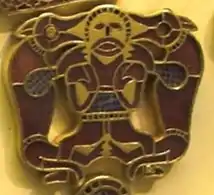 | |
The ship-burial treasure was presented to the nation by the owner, Edith Pretty, and was at the time the largest gift made to the British Museum by a living donor.[158] The principal items are now permanently on display at the British Museum. A display of the original finds excavated in 1938 from Mounds 2, 3 and 4, and replicas of the most important items from Mound 1, can be seen at the Ipswich Museum.
In the 1990s, the Sutton Hoo site, including Sutton Hoo House, was given to the National Trust by the Trustees of the Annie Tranmer Trust. At Sutton Hoo's visitor centre and Exhibition Hall, the newly found hanging bowl and the Bromeswell Bucket, finds from the equestrian grave, and a recreation of the burial chamber and its contents can be seen.
The 2001 Visitor Centre was designed by van Heyningen and Haward Architects for the National Trust. Their work included the overall planning of the estate, the design of an exhibition hall and visitor facilities, car parking and the restoration of the Edwardian house to provide additional facilities.[159]
The £5m visitor centre was opened in March 2002 by Nobel laureate Seamus Heaney, who had published a translation of Beowulf.[160]
Representation in creative media
The Wuffings (1997) by Ivan Cutting and Kevin Crossley-Holland reimagines the events leading to the Mound 1 burial.[161][162]
The Dig (2007) is an historical novel by John Preston, the nephew of Margaret Guido, which reimagines the events of the 1939 excavation.[163][164] A Netflix-produced film adaptation of the novel, starring Carey Mulligan and Ralph Fiennes, was released in January 2021.[165]
The landscape of Sutton Hoo features in the Assassin's Creed Valhalla video game released in 2020.[166]
Notes
- A full description of the locality and environment has been produced by Rupert Bruce-Mitford.[5]
- Archaeological studies of this region include the East Anglian Kingdom project and, since 1974, the Ipswich Excavation Project, undertaken for Suffolk County Council and spearheaded by Keith Wade.
- The example from Eschwege, Niederhonen in the Lower Werra valley, a tributary of the River Weser, is displayed at Kassel Museum, Germany.
- See, e.g., Campbell 1992. Carver, Sutton Hoo, pp. 22–23, says Chadwick's identification was "repeatedly endorsed by other scholars for fifty years", and that Raedwald "is still the favourite candidate"; see also pp. 172–173 and notes.
- See also Henderson 1987; Henderson 1999, pp. 19–53, though the Pictish influences are seen by many, including David M. Wilson, as flowing the other way.
- The fragments were used first in 1945–1946[67][68] by Herbert Maryon to produce the reconstructed helmet that was displayed at the Festival of Britain in 1951, but were reinterpreted by Nigel Williams in 1970–1971[69][70] using materials not previously identified, and methods not previously possible. It was from this second reconstruction that a replica helmet has been based.[71]
- That is, in the sense of the Imitatio Imperii Romanorum, not meaning an actual imperial claim.
- Pressblech metal foils were impressed in a single operation using a hard die over a softer supporting surface, unlike repoussé work in which the pattern is raised manually.[103]
- John Jacobs described what he and Basil Brown found in a short recorded commentary which can be heard on the aural history earpieces at Sutton Hoo National Trust Exhibition Hall.
References
- "AD 700 – Sutton Hoo". Current Archaeology. 2007. Retrieved 3 October 2010.
- "Sutton". Key to English place names. University of Nottingham. Retrieved 24 February 2014.
- "Lost Myths of Time: Sutton Hoo". Stanford.edu. Retrieved 9 June 2020.
- Matthews, Constance Mary (1974). How place names began, and how they develop. Lutterworth Press. ISBN 9780718820060.
- Bruce-Mitford 1975, pp. 1–98.
- West 1998, pp. 261–275.
- West 1998, pp. 9–10, 92–93, 99.
- West 1998, pp. 12–13.
- West 1998, pp. 91, 100–101.
- Bruce-Mitford 1974, pp. 114–140.
- Wade 2001.
- West, Scarfe & Cramp 1984.
- Bruce-Mitford 1974, 73–113; however Kingston near Woodbridge (nearly opposite Sutton Hoo) is "another possibility".
- Carver 1998, pp. 94–96.
- Carver 1998, pp. 97–99.
- Hoppit, Rosemary (2001). "I have a little something that may be of interest to you" (PDF). Saxon. Sutton Hoo Society. 34: 1. Retrieved 18 June 2017.
- Carver, Sutton Hoo, p. 99.
- Carver 1998, p. 100.
- Toby F. Martin, The Cruciform Brooch and Anglo-Saxon England (2015: Boydell and Brewer), pp. 174-175
- Catherine Hills, "The Anglo-Saxon Migration: An Archaeological Case Study of Disruption," in Migration and Disruptions: Toward a Unifying Theory of Ancient and Contemporary Migrations, ed. Brenda J. Baker and Takeyuki Tsuda (2015: University Press of Florida), pp. 47-48
- Ken R. Dark, "Large-scale population movements into and from Britain south of Hadrian's Wall in the fourth to sixth centuries AD" (2003)
- Carver 1998, pp. 103–104.
- Carver 1998, p. 107.
- "Sutton Hoo: Anglo-Saxon ship burial - Google Arts & Culture". Google Cultural Institute. Retrieved 12 August 2017.
- Bruce-Mitford 1975, pp. 108–110, 112–115, 125–126.
- Bruce-Mitford 1975, pp. 124–125, 131.
- Carver 1998, pp. 107–110.
- Bruce-Mitford 1975, pp. 230–344; Evans 2001, p. 54.
- Carver 1998, pp. 113–116.
- Carver, Sutton Hoo, pp. 92, 133, 167.
- Carver, Sutton Hoo, 81–90, 110–116, plates III-V.
- The analysis of the bridle and mounts is presented by Angela Evans in Carver 2005, 201–281.
- Plunkett 2005, pp. 51–53.
- Caruth & Anderson 1999.
- West 1998, pp. 31–32, 83–86.
- Carver, Sutton Hoo, pp. 81–82, 116.
- For the original discovery and finds, and their analysis, see Bruce-Mitford 1975, 104–117, 110–111.
- Carver, Sutton Hoo, pp. 75–81, 116–121.
- Bruce-Mitford 1975, pp. 115–121.
- Carver, Sutton Hoo, 79–81
- Carver, Sutton Hoo, pp. 72–75 137–147.
- Described by Jon Newman in Carver 2005,483–487.
- Mango et al. 1989, p. 297.
- See the legend of Saint Æthelred.
- See Plunkett 2002, 22.
- Akbar, Arifa (25 September 2009). "Golden hoard sheds light on Dark Ages - Home News, UK - The Independent". www.independent.co.uk. Retrieved 3 October 2010.
- "AD 700 – Sutton Hoo: Current Archaeology". www.archaeology.co.uk. Retrieved 3 October 2010.
- A.C. Evans and R. Bruce-Mitford in Bruce-Mitford 1975, 345–435; Evans 1986, 23–29. For its context in symbolism, see Crumlin-Pederson 1995.
- Bruce-Mitford 1975, pp. 176–180; Evans 1986, pp. 32–40.
- Bruce-Mitford 1975, pp. 144–156.
- Carver, Sutton Hoo, pp. 132–135. Several mounds remain unexcavated, see p. 179.
- Bruce-Mitford 1975, pp. 488–577.
- "British Museum - Who was buried at Sutton Hoo?". www.britishmuseum.org. Archived from the original on 16 December 2010. Retrieved 19 October 2010.
- Carver 1998, 188, Ch. 3 n.13.
- Chadwick, H. Munro (1940). "The Sutton Hoo Ship-Burial. VIII. Who Was He?". Antiquity. 14 (53): 76–87. doi:10.1017/S0003598X00014812.
- Bruce-Mitford 1975, pp. 683–717.
- Hilts 2019, p. 48.
- "Hands on with the Sutton Hoo sword I Curator's Corner Season 5 Episode 1 - YouTube". www.youtube.com. Retrieved 17 January 2021.
- Härke, Heinrich (1990). ""Warrior Graves"? The Background of the Anglo-Saxon Weapon Burial Rite". Past & Present (126): 22–43. ISSN 0031-2746.
- Wilson 1984, p. 25.
- Henderson & Henderson 2004, p. 16.
- Bruce-Mitford 1978, pp. 138–231; Evans 1986, pp. 46–49.
- Bruce-Mitford 1974, 210–222; Bruce-Mitford 1986; Evans 1986, 111–117; Evans 2001. cf Arwidsson 1934.
- Evans 1986, p. 49.
- Bruce-Mitford 1978, p. 206, Fig. 153.
- See, e.g. Leahy and Bland 2009, p. 25.
- Bruce-Mitford 1946, pp. 2–4.
- Martin-Clarke 1947, p. 63 n.19.
- Bruce-Mitford 1972, p. 123.
- Williams 1992, p. 88.
- Bruce-Mitford 1974, pp. 198–209.
- Bruce-Mitford 1983a, pp. 69–146.
- Evans 1986, pp. 59–63; Plunkett 2001, pp. 66–71.
- Bruce-Mitford 1978, pp. 241–272.
- Bruce-Mitford 1978, pp. 394–402; Evans 1986, pp. 92–93.
- British Museum Highlights Archived 21 October 2012 at the Wayback Machine, Sword from the ship-burial at Sutton Hoo; Bruce-Mitford 1978, 273–310; Evans 1986, 42–44.
- Evans 1986, pp. 44–46.
- Bruce-Mitford 1978, pp. 432–625; Evans 1986, p. 109.
- Bruce-Mitford 1978, 536–563; Evans 1986, 8991; Plunkett 2001, 73–75. It is 13.2 centimetres (5.2 in) long, weighing 414 grams (14.6 oz).
- Bruce-Mitford 1978, pp. 523–535, 584–589.
- Evans 1986, 85–88. Compare, for instance, the Prima Porta statue of Augustus.
- Bruce-Mitford 1978, pp. 487–522; Evans 1986, pp. 87–88.
- Kendrick, T.D. (1940). "The Sutton Hoo Ship-Burial. II. The Gold Ornaments". Antiquity. 14 (53): 28–30. doi:10.1017/S0003598X00014757.
- Bruce-Mitford 1975, 685–690; Evans 1986, 83–93; Plunkett 2005, 89–96.
- Bruce-Mitford 1975, pp. 578–677.
- See Scarfe 1982, 30–37 for an attempt to link them to the story of Raedwald.
- Evans 1986, pp. 88–89.
- Bruce-Mitford 1983a, pp. 316–346; Evans 1986, pp. 64–68.
- Bruce-Mitford 1975, pp. 117–118.
- Bruce-Mitford 1983a, pp. 347–360; Evans 1986, pp. 64–68.
- Bruce-Mitford 1978, pp. 232–240; Evans 1986, p. 41.
- Bruce-Mitford 1983a, pp. 244–262, 282–295.
- See K. East in Bruce-Mitford 1983 (II), 788–812.
- Bruce-Mitford 1983b, pp. 833–843.
- Bruce-Mitford 1983a, pp. 45–61.
- Bruce-Mitford 1983a, pp. 151–153; Bruce-Mitford 1983b, pp. 813–832, 853–874; Evans 1986, pp. 57–59, 68–70.
- Bruce-Mitford 1983a, pp. 146–151.
- Bruce-Mitford 1983a, pp. 4–44; Evans 1986, pp. 57–58.
- Phillips 1940, p. 175; Bruce-Mitford 1975, p. 547.
- Bruce-Mitford 1974, pp. 3–4; Evans 1986, p. 57.
- Bruce-Mitford 1978, 403–431. This has been interpreted as a flambeau or a standard.
- Bruce-Mitford 1978, pp. 1–129.
- Coatsworth & Pinder 2002, pp. 109–114.
- Stolpe & Arne 1927.
- Bruce-Mitford 1986; Evans 1986, pp. 49–55, 111–119.
- British Museum Highlights Archived 18 October 2015 at the Wayback Machine, Sceptre from the ship-burial at Sutton Hoo; Bruce-Mitford 1978, 311–393; Bruce-Mitford 1986; Evans 1986, 83–5; Plunkett 2001, 71–73.
- Campbell, James. The Anglo-Saxons (1991) ISBN 0-14-014395-5
- The Sutton Hoo tubs and buckets are described by K. East in Bruce-Mitford 1983 (II), 554–596.
- Bruce-Mitford 1983b, pp. 732–757; Evans 1986, p. 63.
- Bruce-Mitford 1974, 188–197; Bruce-Mitford 1983 (II), 611–731; Evans 1986, 69–72. The lyre was at first reconstructed as a single-armed harp with horizontal soundbox.
- Kendrick, T.D. (1940). "The Sutton Hoo Ship-Burial. II. The Gold Ornaments". Antiquity. 14 (53): 28–30. doi:10.1017/S0003598X00014757.; Bruce-Mitford 1983 (I), 206–243, 264–281, 300–306; Evans 1986, 72–75.
- See A.C. Evans in Bruce-Mitford 1983 (II), 480–510.
- See V.H. Fenwick in Bruce-Mitford 1983 (II), 511–553.
- See E. Crowfoot in Bruce-Mitford 1983 (II), 409–479.
- United States National Museum (1892). Report upon the condition and progress of the U.S. National Museum. G.P.O. p. 606. Retrieved 8 October 2010.
- Judith Jesch (2002). The Scandinavians from the Vendel period to the tenth century. Boydell Press. p. 47. ISBN 0-85115-867-6. Retrieved 8 October 2010.
- Robert E. Bjork, John D. Niles (1998). A Beowulf Handbook. U of Nebraska Press. p. 291. ISBN 0-8032-6150-0. Retrieved 8 October 2010.
- Bruce-Mitford 1974, pp. 17–35.
- Arrhenius 1983.
- E.g. Taplow, Broomfield or Prittlewell
- du Chaillu 1889, II, 42-46.
- Carver 1998, pp. 137–143.
- Plunkett 2005, p. 173.
- Bruce-Mitford 1974, pp. 35–55.
- Davidson, Hilda Ellis (1968). "Archaeology and Beowulf". Beowulf and its analogues. Dent.
- Frank, Roberta (1992). "Beowulf and Sutton Hoo: The Odd Couple". Voyage to the Other World: The Legacy of Sutton Hoo. University of Minnesota Press. p. 47.
- Newton 1993.
- Carver 1998, p. 147.
- Carver 1998, pp. 148–153.
- The Ipswich Journal 1860.
- Hoppitt 1985.
- Carver, Sutton Hoo, pp. 3–4, 153.
- Carver 1998, p. 4.
- ODNB, Basil John Wait Brown. Brown's diaries of the 1938 and 1939 excavations are published in Bruce-Mitford 1974, 141–169.
- Carver 1998, pp. 4–5.
- Bruce-Mitford 1975, pp. 100–131; Markham 2002, pp. 12–14.
- Bruce-Mitford 1975, pp. 100–136.
- Carver 1998, p. 7.
- Evans 1986.
- Descriptions of the excavation are given as follows: Bruce-Mitford 1975, 156–222; Carver Sutton Hoo, pp. 9–11; Markham 2002. (Markham's published narrative is based on unpublished correspondence of Basil Brown and others held by the British Museum, the Ipswich Museum, and the Suffolk County Council Archaeological Service.)
- Carver 1998, p. 12.
- See Charles Phillips's diary of the excavation (Carver Sutton Hoo, pp. 11–20)
- Clark 1985; Phillips 1987, pp. 70–80; Plunkett 1998, pp. 182, 189; Markham 2002, pp. 8–9, 31–35.
- Carver, Sutton Hoo, p. 18.
- Bruce-Mitford 1975, pp. 718–731.
- Markham 2002, pp. 50–54.
- Carver 1998, pp. 25–26.
- Phillips 1940;Crawford, O.G.S. (1940). "Editorial Notes". Antiquity. 14 (53): 1–5. doi:10.1017/S0003598X00014733.
- Carver 1998, pp. 26–31.
- Carver 1998, p. 32.
- Bruce-Mitford 1975, pp. 230–344.
- Four physical volumes; Carver Sutton Hoo, pp. 41, 185
- Carver 1998, p. 43.
- Carver 1998, pp. 45–47.
- Carver 1998, pp. 48–49.
- Carver 2005.
- "Sutton Hoo Ship Burial". Smarthistory at Khan Academy. Retrieved 25 February 2013.
- Carver 1998, p. 22.
- Dawson 2002.
- Kennedy, Maev (14 March 2002). "Sutton Hoo lays out its treasures". The Guardian. Retrieved 2 February 2018.
- "Anglo-Saxon platitudes". The Independent. 12 July 1997. Retrieved 12 November 2020.
- Clarke, Andrew. "Eastern Angles to mark 30 years on the road". East Anglian Daily Times. Retrieved 12 November 2020.
- Manthorpe, Rowland (12 May 2007). "Review: The Dig by John Preston". the Guardian. Retrieved 31 October 2020.
- "My buried history". The Telegraph. Retrieved 12 November 2020.
- "The Dig: Ralph Fiennes Makes A Historic Discovery In Netflix Adaptation – Exclusive First-Look Image". Empire. 28 October 2020. Retrieved 31 October 2020.
- "Assassin's Creed Valhalla: How to Get Sutton Hoo Armor Wealth". Game Rant. 28 November 2020. Retrieved 7 February 2021.
Bibliography
- Arrhenius, Birgit (1983). "The chronology of the Vendel graves". In Lamm, Jan Peder & Nordstrom, Hans-Åke (eds.). Vendel Period Studies: transactions of the Boat-Grave Symposium in Stockholm, February 2–3, 1981. Studies – The Museum of National Antiquities, Stockholm. 2. Stockholm: Statens Historiska Museum. pp. 39–70. ISBN 978-91-7192-547-3.
- Bruce-Mitford, Rupert (September 1946). "Sutton Hoo Ship-Burial". East Anglian Magazine. 6 (1): 2–9, 43.
- Bruce-Mitford, Rupert (Autumn 1972). "The Sutton Hoo Helmet: A New Reconstruction". The British Museum Quarterly. British Museum. XXXVI (3–4): 120–130. doi:10.2307/4423116. JSTOR 4423116.
- Bruce-Mitford, Rupert (1974). Aspects of Anglo-Saxon Archaeology: Sutton Hoo and Other Discoveries. London: Victor Gollancz.
- Bruce-Mitford, Rupert (1975). The Sutton Hoo Ship-Burial, Volume 1: Excavations, Background, the Ship, Dating and Inventory. London: British Museum Publications. ISBN 0-7141-1334-4.
- Bruce-Mitford, Rupert (1978). The Sutton Hoo Ship-Burial, Volume 2: Arms, Armour and Regalia. London: British Museum Publications. ISBN 9780714113319.
- Bruce-Mitford, Rupert (1983a). The Sutton Hoo Ship-Burial, Volume 3: Late Roman and Byzantine silver, hanging-bowls, drinking vessels, cauldrons and other containers, textiles, the lyre, pottery bottle and other items. I. London: British Museum Publications. ISBN 0-7141-0529-5.
- Bruce-Mitford, Rupert (1983b). The Sutton Hoo Ship-Burial, Volume 3: Late Roman and Byzantine silver, hanging-bowls, drinking vessels, cauldrons and other containers, textiles, the lyre, pottery bottle and other items. II. London: British Museum Publications. ISBN 0-7141-0530-9.
- Bruce-Mitford, Rupert (1986). "The Sutton Hoo Ship-Burial: Some Foreign Connections". Angli e Sassoni al di qua e al di là del mare: 26 aprile-lo maggio 1984. Settimane di studio del Centro italiano di studi sull'alto Medioevo. XXXII. Spoleto: Centro italiano di studi sull'alto Medioevo. pp. 171–210.
- Campbell, James (1992). "The Impact of the Sutton Hoo Discovery on the Study of Anglo-Saxon History". In Kendall, Calvin B. & Wells, Peter S. (eds.). Voyage to the Other World: The Legacy of the Sutton Hoo. Medieval Cultures. 5. Minneapolis: University of Minnesota Press. pp. 79–101. ISBN 0-8166-2023-7. JSTOR 10.5749/j.ctttv0mr.8.

- Carver, M. O. H. (1998). Sutton Hoo: Burial Ground of Kings?. London: British Museum. ISBN 978-0-7141-0599-4.
- Carver.M.O.H. (Ed.), Bulletins of the Sutton Hoo Research Committee 1983–1993 (Boydell, Woodbridge 1993).
- Carver, Martin (2005). Sutton Hoo: A seventh-century princely burial ground and its context. London: British Museum Press. ISBN 978-0-7141-2322-6.
- Carver, Martin (2017) The Sutton Hoo Story. Encounters with Early England (Boydell Press) ISBN 978 178327 204 4
- Caruth, Joanna & Anderson, Sue (June 1999). "RAF Lakenheath Anglo-Saxon Cemetery". Current Archaeology. Current Publishing. 14 (163): 244–250. ISSN 0011-3212.
- Clark, Grahame (1985). "The Prehistoric Society: From East Anglia to the World". Proceedings of the Prehistoric Society. Cambridge: Cambridge University Press. 51: 1–14. doi:10.1017/S0079497X0000699X.
- Coatsworth, Elizabeth & Pinder, Michael (2002). Hines, John & Catherine, Cubitt (eds.). The Art of the Anglo-Saxon Goldsmith: Fine Metalwork in Anglo-Saxon England, its Practice and Practitioners. Anglo-Saxon Studies. 2. Woodbridge: The Boydell Press. ISBN 0-85115-883-8.
- Dawson, Susan (10 October 2002). "Modest building fit for a king". The Architects' Journal. Emap Construct: 4–7.

- P. du Chaillu, 1889, The Viking Age (2 Vols). London: John Murray.
- Evans, Angela Care (1986). The Sutton Hoo Ship Burial. London: British Museum Publications. ISBN 978-0-7141-0544-4.
- Evans, Angela Care (2001). "Sutton Hoo and Snape, Vendel and Valsgärde". In Hultén, Pontus & von Plessen, Marie-Louise (eds.). The true story of the Vandals. Museum Vandalorum Publications. 1. Värnamo: Museum Vandalorum. pp. 48–64. ISSN 1650-5549.
- W. Filmer-Sankey and T. Pestell, Snape Anglo-Saxon Cemetery: Excavations and Surveys 1824–1992 (East Anglian Archaeology 95, Suffolk County Council 2001).
- S. Heaney, Beowulf (Faber 1999).
- Henderson, George D. S. (1987). From Durrow to Kells: the Insular gospel-books 650–800. London: Thames & Hudson. ISBN 9780500234747.
- Henderson, George D. S. (1999). Vision and Image in Early Christian England. Cambridge: Cambridge University Press. ISBN 9780521551304.
- Henderson, George D. S. & Henderson, Isabel (2004). The Art of the Picts: Sculpture and Metalwork in Early Medieval Scotland. London: Thames & Hudson. ISBN 9780500238073.
- Hilts, Carly (October 2019). "What's New at Sutton Hoo?". Current Archaeology. London, UK: Current Publishing (355).
- Hoppitt, Rosemary (1985). "Sutton Hoo 1860" (PDF). Proceedings of the Suffolk Institute of Archaeology. Ipswich: Society of Antiquaries of London. XXXVI (1): 41–42.
- Mango, Marlia Mundell; Mango, Cyril; Evans, Angela Care & Hughes, Michael (June 1989). "A 6th century Mediterranean bucket from Bromeswell parish, Suffolk". Antiquity. 63 (239): 295–311. doi:10.1017/S0003598X00076018.
- Markham, Robert A. D. (2002). Sutton Hoo: through the rear view mirrow, 1937–1942. Woodbridge: Sutton Hoo Society. ISBN 9780954345303.
- Martin-Clarke, D. Elizabeth (1947). Culture in Early Anglo-Saxon England. Baltimore: Johns Hopkins Press.
- Newton, Sam (1993). The Origins of Beowulf and the Pre-Viking Kingdom of East Anglia. Cambridge: D. S. Brewer. ISBN 0-85991-361-9.
- Phillips, Charles W. (April 1940). "The Excavation of the Sutton Hoo Ship-burial". The Antiquaries Journal. Society of Antiquaries of London. XX (2): 149–202. doi:10.1017/S0003581500009677.
- C.W. Phillips, T.D. Kendrick, E. Kitzinger, O.G.S. Crawford, W.F. Grimes and H.M. Chadwick, The Sutton Hoo Ship-Burial (Antiquity, March 1940).
- Phillips, Charles W. (1987). My Life in Archaeology. Gloucester: Alan Sutton. ISBN 0-86299-362-8.
- Plunkett, Steven J. (1998). "The Suffolk Institute of Archaeology: its Life, Times and Members" (PDF). XXXIX (2). Ipswich: Society of Antiquaries of London: 165–207. Cite journal requires
|journal=(help) - Plunkett, Steven J. (2001). "Items from the Ship-Burial at Sutton Hoo, Suffolk". In Hultén, Pontus & von Plessen, Marie-Louise (eds.). The true story of the Vandals. Museum Vandalorum Publications. 1. Värnamo: Museum Vandalorum. pp. 65–75. ISSN 1650-5549.
- S.J. Plunkett, Sutton Hoo, Suffolk Site guidebook (The National Trust, London 2002).
- Plunkett, Steven J. (2005). Suffolk in Anglo-Saxon Times. Stroud: Tempus. ISBN 0-7524-3139-0.
- "Roman Mounds or Barrows". Woodbridge. The Ipswich Journal (6, 342). Ipswich. 24 November 1860. p. 5. Retrieved 16 April 2017.

- Stolpe, Hjalmar & Arne, T. J. (1927). La Nécropole De Vendel. Stockholm: Akademiens Förlag.
- Wade, Keith (2001). "Gipeswic – East Anglia's first economic capital, 600–1066". In Salmon, Neil & Malster, Robert (eds.). Ipswich from the First to the Third Millennium: Papers from an Ipswich Society Symposium. Ipswich: Ipswich Society. pp. 1–6. ISBN 9780950732817.
- West, Stanley E. (1998). Aspects of Anglo-Saxon Archaeology: Sutton Hoo and Other Discoveries (PDF). East Anglian Archaeology (Report). Ipswich: Suffolk County Council. ISBN 0-86-055-24-62.
- West, Stanley E.; Scarfe, Norman & Cramp, Rosemary (1984). "Iken, St Botolph, and the Coming of East Anglian Christianity" (PDF). Proceedings of the Suffolk Institute of Archaeology. Ipswich: Society of Antiquaries of London. XXXV (4): 279–301.
- Williams, Nigel (1992). "The Sutton Hoo Helmet". In Oddy, William Andrew (ed.). The Art of the Conservator. London: British Museum Press. pp. 73–88. ISBN 9780714120560.
- Wilson, David M. (1984). Anglo-Saxon Art: From The Seventh Century To The Norman Conquest. London: Thames and Hudson. ISBN 978-0-500-23392-4.
- Oxford Dictionary of National Biography: Basil J.W. Brown, Rupert L.S. Bruce-Mitford, Charles W. Phillips.
Further reading
- Arwidsson, Greta (1934). "A New Scandinavian Form of Helmet from the Vendel-Time". Acta Archaeologica. V: 243–257. ISSN 0065-101X.
- Care Evans, Angela (1986). The Sutton Hoo Ship Burial (British Museum Press).
- Carver, Martin, ed. (1992). The Age of Sutton Hoo: The seventh century in north-western Europe. Woodbridge: Boydell Press. ISBN 0-85115-330-5. Retrieved 27 May 2017.
- Carver, Martin (2017). The Sutton Hoo Story: Encounters with Early England (2017) includes an account of all the excavation campaigns at Sutton Hoo from 1938 to 1992.[1][2]
- Crumlin-Pedersen, Ole & Thye, Birgitte Munch, eds. (1995). The Ship as Symbol in Prehistoric and Medieval Scandinavia: Papers from an International Research Seminar at the Danish National Museum, Copenhagen, 5th–7th May 1994. Publications from the National Museum. Studies in archaeology & history. 1. Copenhagen: National Museum of Denmark, Department of Archaeology and Early History. ISBN 9788789384016.
- Engstrom, Robert; Lankton, Scott Michael & Lesher-Engstrom, Audrey (1989). A Modern Replication Based on the Pattern-Welded Sword of Sutton Hoo. Kalamazoo: Medieval Institute Publications, Western Michigan University. ISBN 0-918720-29-X.
- Fairclough, John & Plunkett, Steven J. (2000). "Drawings of Walton Castle and other monuments in Walton and Felixstowe" (PDF). Proceedings of the Suffolk Institute of Archaeology. Ipswich: Society of Antiquaries of London. XXXIX (4): 419–459.
- Farrell, Robert T. (1972). Beowulf, Swedes and Geats (PDF). London: Viking Society for Northern Research.

- Farrell, Robert T. & Neuman de Vegvar, Carol L., eds. (1992). Sutton Hoo: Fifty Years After. American Early Medieval Studies. 2. Oxford, Ohio: American Early Medieval Studies, Miami University, Department of Art. ISBN 9781879836013.
- Green, Charles (1963). Sutton Hoo: The Excavation of a Royal Ship-Burial. New York: Barnes & Novle.
- Mayr-Harting, Henry (1972). The Coming of Christianity to Anglo-Saxon England. University Park: Pennsylvania State University Press. ISBN 978-0271007694.
- Leahy, Kevin & Bland, Roger (2009). The Staffordshire Hoard. London: British Museum Press. ISBN 978-0-7141-2328-8.
- Newton, Sam (2003). The Reckoning of King Rædwald: The Story of the King linked to the Sutton Hoo Ship-Burial. Brightlingsea: Red Bird Publishing. ISBN 9781902626321.
- Scarfe, Norman (1986). Suffolk in the Middle Ages. Woodbridge: Boydell Press. ISBN 978-1-84383-068-9.
- Warner, Peter (1996). The Origins of Suffolk. Manchester and New York: Manchester University Press. ISBN 0-7190-3817-0.
External links
| Wikimedia Commons has media related to Sutton Hoo. |
- Sutton Hoo, at the National Trust website
- 'Sutton Hoo: the Grandest Anglo-Saxon Burial of All', from Current Archaeology on-line magazine 17 November 2002.
- 'Sutton Hoo:Burial Ground of the Wuffings', by Sam Newton.
- The Sutton Hoo Society website
- BBC Look East news clip on the recreated burial ship at Sutton Hoo. Retrieved 16 July 2011 (viewable only to people in the UK or by using a UK proxy).
- Sutton Hoo burials: reconstructing the sequence of events, M. Hummler and A Roe, Interpreting Stratigraphy 8, University of York, 1996, York. ISBN 0946722145
- Discussion of shoulder clasps by Janina Ramirez and Jim Peters: Art Detective Podcast, 01 Feb 2017
.JPG.webp)
.JPG.webp)
.JPG.webp)
.JPG.webp)
.jpg.webp)
